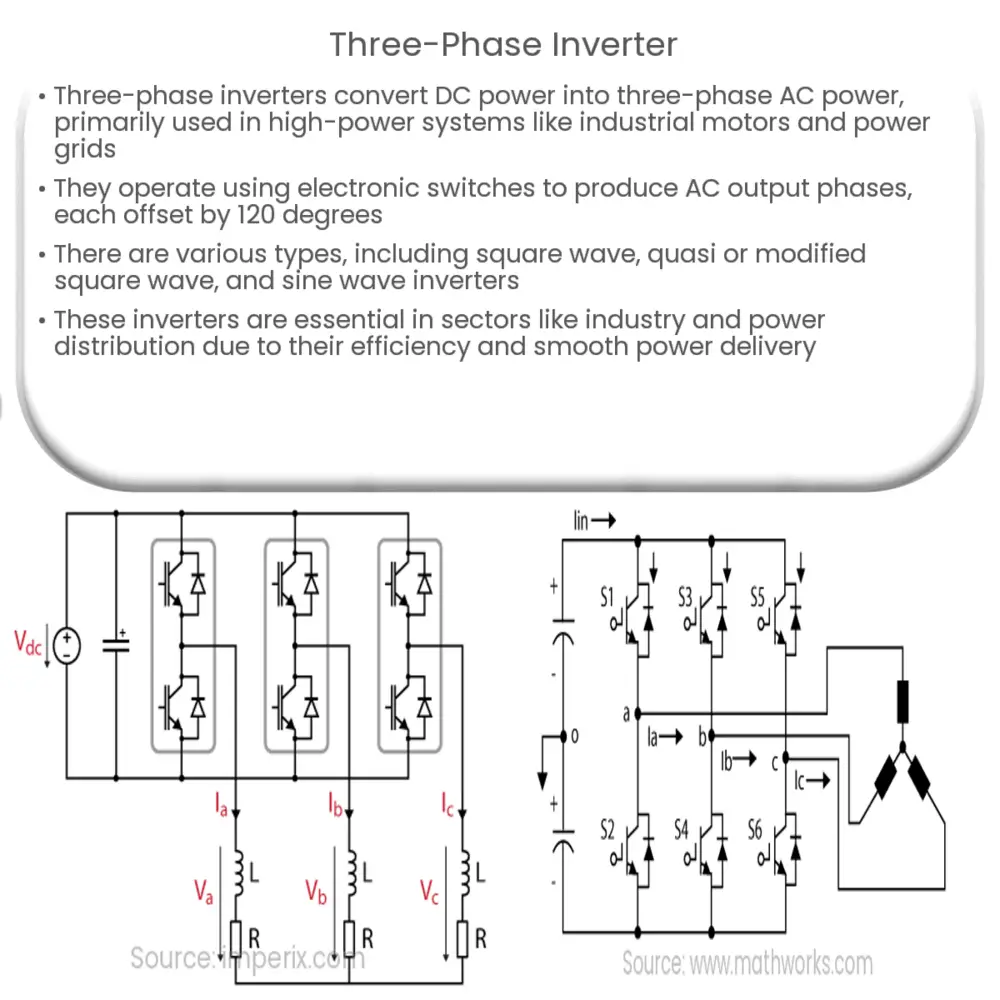Explore the workings, types, applications, advantages, and limitations of three-phase inverters in our comprehensive guide.

Introduction to Three-Phase Inverters
A three-phase inverter is an electronic device that accepts DC power input and converts it into three-phase AC power. The primary application of three-phase inverters is in high-power systems such as industrial motors and residential power grids where three-phase AC power is standard.
Working Principle of Three-Phase Inverters
At the heart of a three-phase inverter is a set of electronic switches. These switches are controlled to open and close in a specific sequence, thus changing the input DC voltage into three separate AC output phases. Each phase is offset by 120 degrees from the others, which is a defining characteristic of three-phase power.
Types of Three-Phase Inverters
- Square Wave Inverters: These are the simplest type of three-phase inverters. They generate a square waveform, which is not as efficient or smooth as the sine wave produced by other types of inverters.
- Quasi or Modified Square Wave Inverters: These inverters produce a waveform that is an improvement over the square wave inverters but still not quite as smooth as a pure sine wave.
- Sine Wave Inverters: These are the most complex type of three-phase inverter. They produce a smooth sine wave output that is very similar to the AC power supplied by the power grid.
Applications of Three-Phase Inverters
Three-phase inverters are used in a wide range of applications, including:
- Industrial Motors: Three-phase motors are common in industry, and these require a three-phase power source to operate efficiently. Inverters are used to convert DC power into the necessary three-phase AC power.
- Power Grids: Many power grids distribute electricity as three-phase AC power. Inverters can be used to convert DC power from sources like solar panels into AC power that can be fed into the grid.
- Uninterruptible Power Supplies (UPS): In a UPS system, an inverter is used to convert DC power from a battery or other source into AC power, ensuring a constant supply of electricity even during a power outage.
Next, we will look at the advantages and limitations of three-phase inverters and delve deeper into their inner workings.
Advantages of Three-Phase Inverters
Three-phase inverters come with numerous advantages, particularly for high-power applications:
- Efficiency: The three-phase power generated by these inverters is more efficient for running large motors compared to single-phase power. This efficiency can result in significant energy savings.
- Smooth Power Delivery: The three-phase output results in smoother power delivery, reducing strain on electrical devices and potentially extending their lifespan.
- Flexibility: Three-phase inverters can be used with a wide range of power sources, from solar panels to batteries, allowing for more flexible power solutions.
Limitations of Three-Phase Inverters
Despite their advantages, there are also some limitations to three-phase inverters:
- Cost: Due to their complexity, three-phase inverters tend to be more expensive than their single-phase counterparts.
- Specialized Knowledge Required: Installation and maintenance of three-phase inverters require a higher level of expertise, which may not be readily available in some areas.
- Not Suitable for Small Applications: For small, low-power applications, the benefits of a three-phase inverter may not outweigh the additional cost and complexity.
Conclusion
In conclusion, three-phase inverters play a vital role in various sectors, from industrial applications to power grids, thanks to their high efficiency and smooth power delivery. Their flexibility in working with different power sources makes them a robust solution for our energy needs. However, their complexity, cost, and requirement for specialized knowledge are factors to consider. Despite these limitations, the advantages they offer make them an essential part of modern power systems. As technology continues to advance, we can expect further improvements in the design and operation of three-phase inverters, increasing their efficiency and making them more accessible for a wider range of applications.

